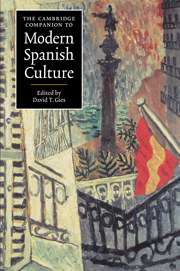Modern Spanish culture
An introduction
Published online by Cambridge University Press: 28 May 2006
Summary
Suddenly, Spain seems to be exporting culture. While the death of Generalisimo Francisco Franco in 1975 failed to usher in the radical shift in literature and the arts predicted by many observers of Spanish culture, it did mark a real conceptual change in Spain's image of itself and of the world's image of Spain. The political and historical phenomenon known as “the Transition” carried Spain away from its old image as a backward, slightly bumbling country toward a new image as a modern, democratic, chic, and vigorous cultural center. For many years, Franco's tourism industry had sold Spain as “different,” and indeed it was, but not in the way government officials hoped it would be perceived. Spain, slow to return to the international community of nations following the devastating Civil War (1936-1939) and the repressive years of the Franco dictatorship (1939-1975), was different in the sense that politically it had not kept up with the rapid move into the modern world experienced in the rest of Europe and was viewed as a pariah among modern nation-states. Spain remained closed to many international influences and proudly put forth its “difference” in images of what Kathleen Vernon in her essay in the present book calls the españolada, that is, the clichéd, tradition-ridden view of flamenco girls, hot-tempered males, sunny beaches, and sculpted landscapes. La España de pandereta (the Spain of the tambourine) - the romantic and Catholic land of Bizet's fiery Carmen and Zorrilla's amorous but repentant Don Juan - was issued forth as the fetichized image of the “real” Spain.
- Type
- Chapter
- Information
- Publisher: Cambridge University PressPrint publication year: 1999
- 41
- Cited by



